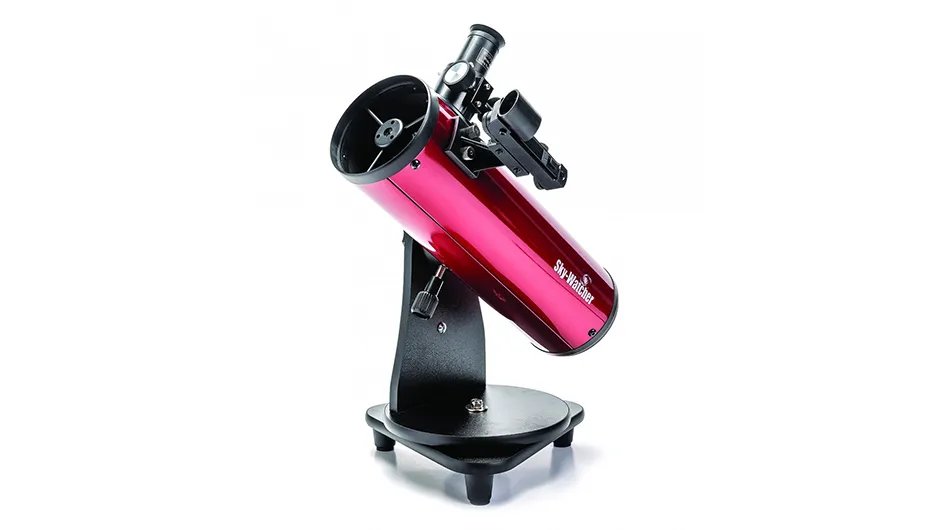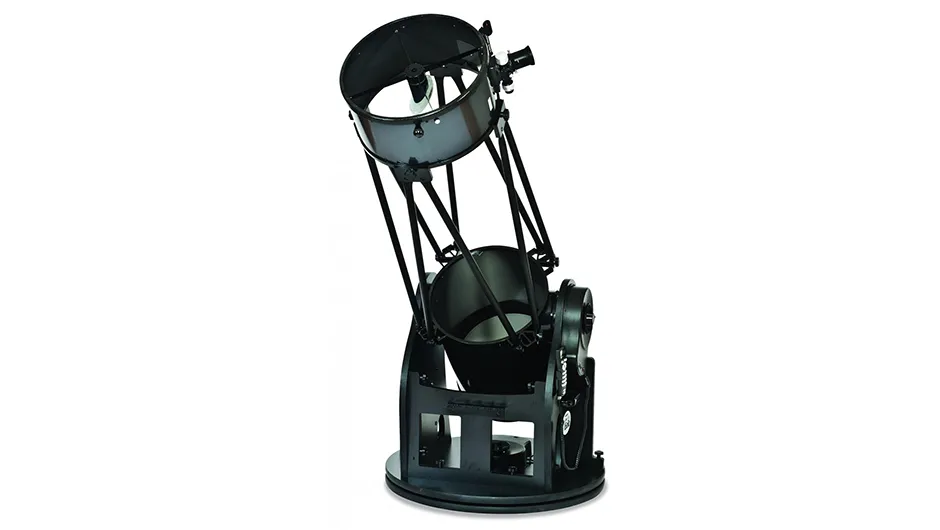The typical elements of a Dobsonian; the one you see here is the 8-inch Bresser Messier. Image Credit: The Secret Studio.
The Dobsonian is a rather unusual – and yet simple – mount and telescope combination.
It was developed in the 1950s by John Dobson, a monk from San Francisco.
He wanted to see views of the night sky comparable to those shown by deep-sky photographs, but could not afford the telescopes of the time.
Much of the cost was in purchasing an equatorial mount, but large optics were also beyond the budget of a monk.
Frustrated, he set about grinding his own mirrors.
He then came up with the ingenious idea of mounting a telescope tube in a rocker box for altitude adjustment, in turn mounted on a turntable for azimuth rotation.
This allowed a large Newtonian telescope to be easily mounted, yet it still could be pointed to any part of the sky.
The simplicity of the design means you can put your money into the optics rather than the mount; as you are not tracking the stars there is no polar alignment to worry about: you just point and view.
This design would make John Dobson a legend amongst amateur astronomers who wanted to observe the denizens of the deep sky without any hassle.
Dobson played down the idea of being the inventor of what we now call the Dobsonian telescope, though he was always a modest man.
There won’t be many seasoned astronomers who have not looked up at the sky through a Dobsonian telescope at one time or another.
Amateur telescope makers carry on that tradition and build their own Dobsonians, with their own additions: adding Teflon bearings; using modern, lightweight materials both in the mirrors and general construction; even pioneering collapsible systems that can fit into the boot of a car and equatorial tracking platforms.
Manufacturers catch on
Eventually commercial telescope manufacturers recognised the popularity of the design and so began the manufacturing of large Dobsonians for sale – which in purists’ terms was heresy, but has allowed many more people to enjoy the benefits of the Dobsonian design.
Standard models have apertures of 8 inches and upwards, and more recently mini Dobsonians have appeared on the market.
These are ideal for casual observers and children as they are even more affordable than a full-size Dobsonian and straightforward to use.
Manufacturers such as Sky-Watcher, SkyVison and Meade have introduced innovations such as truss designs to help reduce weight and make the commercial large instruments collapsible and therefore portable, ideal for taking to a dark sky site away from light pollution.
After the first computerised equatorial and altaz mounts emerged, it was only a matter of time before Dobsonians received the same treatment.
First came automatic tracking, followed in recent years by full Go-To even in altaz mode.
Some people take superb planetary images through their Dobsonians, and with astronomical cameras becoming ever more sensitive these scopes can even be used for basic deep-sky astrophotography.
Yet despite all this innovation the humble, basic Dobsonian is still a favourite choice for many who want a lightbucket for a modest price.
Dobsonians remain popular as they carry on John Dobson’s vision of an affordable, large instrument, and we can confidently predict that the Dobsonian telescope will be around for a very long time.
Dobsonian variants
All Dobs share two traits: simplicity in use and great aperture for their price:
Classic Dobsonian

Standard, undriven Dobsonians are still popular as they require no setting up and have no alignment routines.
They are large: some manufacturers provide them almost ready assembled, others are delivered flatpacked.
Popular models include the Meade LightBridge 10-inch truss tube, Revelation 10-inch Dobsonian and Sky-Watcher Skyliner-250PX.
Mini Dobsonian

Mini Dobsonians are scaled-down variants of John Dobson’s classic.
They are portable and easy to use – and therefore ideal for children.
They can usually be placed on a table.
A few have even been computerised, such as the Sky-Watcher Heritage-90 Virtuoso.
Basic models include the Sky-Watcher Heritage-76, Meade LightBridge Mini 130 and Celestron FirstScope.
Go-To Dobsonian

For those who prefer maximum time viewing and are less interested in locating objects using star charts, a Go-To Dobsonian is the way forward.
This added versatility transforms the Dobsonian design beyond what John Dobson had ever imagined.
Models include the Sky-Watcher Skyliner-300P and the Orion SkyQuest XX16g Go-To Dobsonian.
Paul Money is BBC Sky at Night Magazine’s reviews editor
